Educator Onboarding
LEO Art Challenge Workshop
ICE 2019: Satellite Tracking, Orbits, and Modeling
SEEC 2019: Satellite Tracking, Orbits, and Modeling
Workshop:ITEC Trek-a-Sat
Workshop: 2018-01-27 Yerkes
Workshop: 2017-10-28 Carthage-Yerkes Electrostatics in Space
Workshop: 2017-06-29-BTCI-Life in Space!
Workshop: 2017-03-11 Yerkes
Workshop: 2017-02-07 SEEC
Workshop: 2017-01-28 Yerkes
Tools You Might Use
Educational Learning
Standards
Documentation
Enzymatic (Liver) Activity in Microgravity Environments
Schița subiectului
-
Author: Laura Tomlin, Salado Middle School, Salado, TX
Frances Dellutri, NSS Director of Education
Assisted by: Natalie Orrantia, Univ of Chicago Updated: August, 2023
SummaryMicrogravity has been determined to have a significant impact on liver function in mice after two weeks in space. This experiment will investigate whether microgravity has an immediate impact on the function of catalase enzymes in the liver, which are responsible for the neutralization of hydrogen peroxide toxin in our bloodstream. Reactants for this experiment will be 1 cc of food-grade, pureed calf liver and 1mL 3% over the counter Hydrogen peroxide.
Students will gain valuable experience in chemistry, anatomy, current space research topics, microgravity, engineering, experimental design, and critical thinking, even before viewing results from the actual flight.
These projects can be modified to suit any classroom.
Age of Students: 11+ years
Project Goals:
To investigate whether microgravity inhibits catalase enzyme activity in the liver.
To demonstrate how gravity is a constant in our lives, and how a change in gravity affects the motion of all matter.
To engineer an apparatus which can be used to conduct and contain a chemical reaction in microgravity.
To provide an authentic learning experience for students which deepen understanding of force and motion, space exploration, human anatomy, the effect of space flight on human health, engineering design process, and scientific inquiry.
Keywords/Topics Covered:
Gravity, Microgravity, Chemical Reactions, Body Systems, Engineering, Scientific Inquiry, Anatomy

Image Credits to GIFGIFs services
US Next Generation Science Standards (NGSS)Properties of Matter PS1.A
Force and Motion PS2.A, PS2.B
Space Systems ESS1.A, ESS1.B
Matter and its interactions PS1.1, PS1.2, PS1.4, PS1.5, PS1.6
Energy PS3.2, PS3.4
From Molecules to Organisms: Structures and Processes LS1.1, LS1.2, LS1.3
Ecosystems, Energy, and Dynamics LS2.4, LS2.5
Engineering Design ETS1.A, ETS1.B, ETS1.C
 Image Credits to GIFGIFs services
Image Credits to GIFGIFs servicesRequired prerequisites / prior knowledge:
Basic Engineering design process
Scientific Inquiry
Forces and Motion: Newton’s Laws, balanced and unbalanced forces, gravity, microgravity, capillary force, adhesion, cohesion
Space Science- Space Research
Organ Systems, Liver function
Chemical properties of matter
Indicators of a chemical change
*All GIF animations credited to GIFGIFs Services* -
1. Reactants, Products, and Leftovers:
This simulation is depicting chemical reactions and reactant combinations, what happens to our reactants and what can we except?
Screenshot of simulation above shows creation of water molecules: Combining hydrogen and oxygen to create H2O, leaving leftover H2 and O2 molecules!
https://phet.colorado.edu/en/simulations/reactants-products-and-leftovers
2. Balancing Chemical Equations:
This simulation teaches the fundamental skill of balancing a chemical equation, fostering the understanding of molecular representations of matter, what happens when chemicals/reactants combine?
Screenshot of simulation above shows the balancing of an equation: The equation shows varying amounts of reactant/product for the combustion of methane.
https://phet.colorado.edu/en/simulations/balancing-chemical-equations -
Background of Lesson:
This is a student driven, authentic research experience provided by Wisconsin Space Grant’s Embedded Teacher Program. The purpose of this experiment is to determine whether microgravity will suppress catalase enzyme activity in calf liver. Students designed equipment and procedures for weightlessness aboard the Zero-G parabolic plane, and conducted the experiment at 1-G in the classroom.
The experiment was subsequently taken on board the Zero-G parabolic plane and repeated in a microgravity simulated environment.
Watch the following videos for crucial background information on the regular functions of the liver as well as the functions of a catalase enzyme in a consistent environment!
Functions of the Liver Video:
Catalase Enzyme Demonstration Video:
Students are first introduced to exothermic chemical changes requiring a catalyst with the classic elephant toothpaste reaction (Activity 1). Students then learn about a similar reaction that occurs in our body- the breakdown of hydrogen peroxide by our liver. Students conduct a short lab experiment in class to investigate how liver damage results in less catalase enzyme activity in our liver, resulting in little to no breakdown of hydrogen peroxide (Activity 2).
Students must complete activities 1 and 2 to continue with the experiment:
Links to these activities found as a file under section heading!
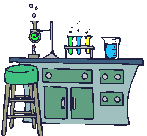
Image Credits to GIFGIFs servicesAfter understanding the role that catalase enzymes and environmental stress play in the breakdown of toxins passing through the liver, students must brainstorm and engineer an apparatus to be used to test catalase enzyme assay in a weightless environment within a 20 second time frame. Students needed to work under the weight, size, and safety constraints required for flight on the Zero-G parabolic plane. Special care was taken to design an apparatus that could contain blood and withstand pressure buildup inside the reaction tube, the apparatus students will use today!
Student Lesson Prep: Liver Function in Microgravity
Ensure students have completed activities 1 and 2 before moving forward!
Broad Research question: How does long term space travel affect the liver and other aspects of human health?
This question cannot be answered with one experiment, but use this lesson to think about how long term space travel can affect different aspects of our health!
Purpose of Our Lesson: Does short term exposure to microgravity affect how catalase enzymes function in the liver?
Create Your Own Hypothesis!
Using the knowledge you gained from activities 1 and 2, form a hypothesis about the results you expect to see from this experiment in 1-g versus 0-g:- Focus on writing your hypothesis with "If, Then" statements!
- "If , then ."
- Have the first blank be what is being changed, and the second blank be the outcome you expect to see as result!
Image Credits to GIFGIFs Services
Here's a short video if you need a little more help visualizing your hypothesis:
-
Elephant Toothpaste Experiment: Student's first introduction to exothermic chemical changes requiring a catalyst, important to set foundation for the experiment later on!
-
Liver Damage Experiment (precursor to the main Liver Enzymatic Activity experiment): Students investigate how liver damage results in less catalase enzyme activity in our liver, established important background information for one of the main topics of our lesson.
-
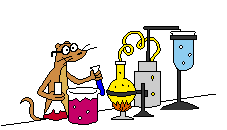
Materials
¼’’ Nylon Tube
Soft Silicone (often times in cure form, like glue)
Quick Release IV Clamp
Hydrogen Peroxide
Common Syringe
Calf Liver Puree
Latex Balloon Image Credits to GIFGIFs Services
Zip ties
Recording Device (can be your phone!)
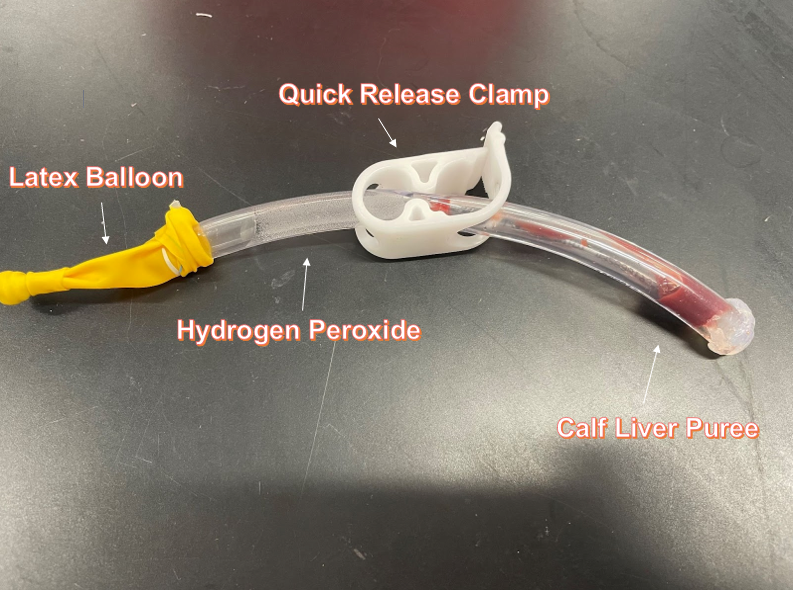
Building Our Apparatus
Construction of catalase enzyme assay:
Cut ¼” interior diameter nylon tube to a length of 10 cm.
Seal end ONE END of tube with soft silicone
Inject 1 mL of hydrogen peroxide into tube
Clamp tube in middle with a quick-release IV clamp, so that the hydrogen peroxide is separated on one side within the tube, having the other side empty
Inject 1 mL of calf liver puree into the nylon tube, separate from the hydrogen peroxide in the empty side from the clamp division
Stretch a small balloon across open end (closest to the liver), and secure with a zip tie
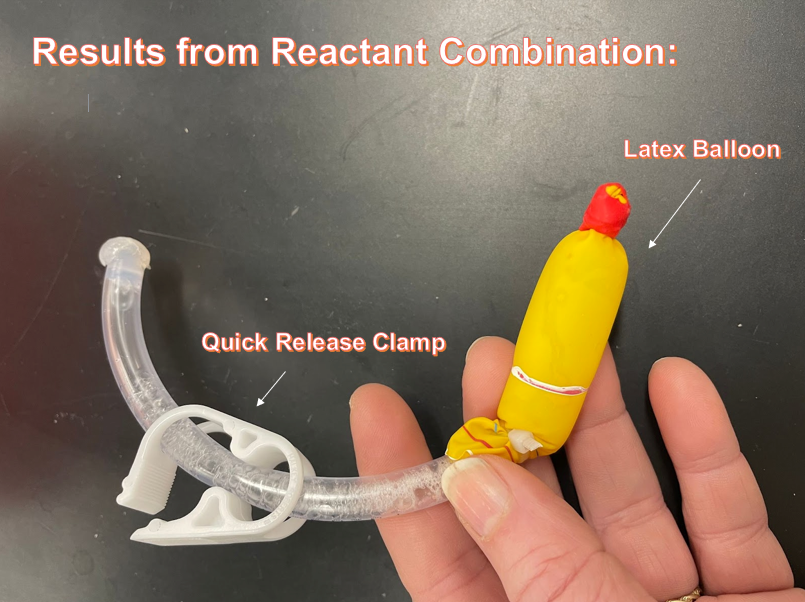
Experimental Procedure
- Begin recording your video
To initiate the reaction, unclasp the clamp
The tube will be given a quick shake to mix the reactants.
The presence of bubbles indicates the breakdown of hydrogen peroxide by catalase enzymes in the liver.
Watch your video back, record the results after 20 seconds
-
Use the following template to record your results; printable version is attached:
This same template will be used for the next activity!
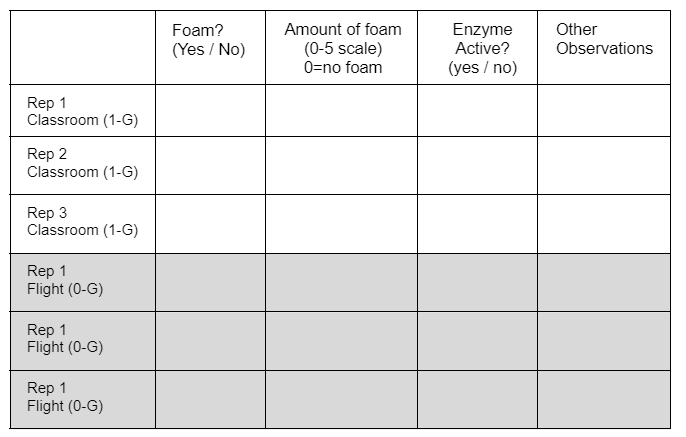

Image Credits to GIFGIFs ServicesMake Your Conclusion:
Students must write their own conclusions after completion of the in-class experiment.
A good conclusion, written in essay format, will include:
- Include an answer to purpose, supported by data (purpose question asked earlier in lesson)
- Include a description of the apparatus and how it works
- Discuss problems with experiment and possible solutions
- How would you change or improve the experiment? (Was there anything you found difficult?)
- Why is this experiment important? (Think about the bigger research question!)
- Include an answer to purpose, supported by data (purpose question asked earlier in lesson)
-
Watch this short clip of our enzyme experiment aboard a zero-g flight:
Image Credits to GIFGIFs Services

Record what you see with the assigned template!
Pay close attention to signs of catalase enzyme activity:
- Is the reactant combination bubbling?
- Do you see any type of activity happening at the release of the clamp?
Record this new data and compare these results to your original hypothesis!
-
Anatomy of the Liver
https://www.stanfordchildrens.org/en/topic/default?id=anatomy-and-function-of-the-liver-90-P03069
NASA Technical Archive (searchable)
-
Send a Postcard to Space through NSS Supported Blue Origin Club For The Future initiative!
Visit: SpacEdge Academy Postcards in Space Course

